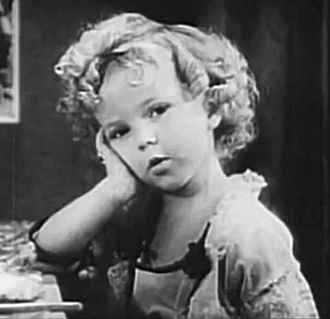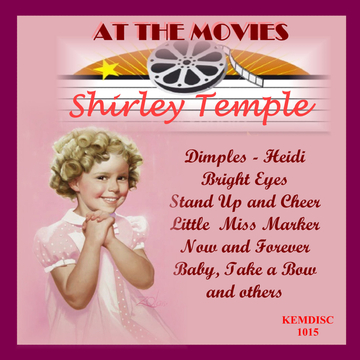
Temple, Shirley
Shirley Temple was born on April 23, 1928, at UCLA Medical Center, Santa Monica in Santa Monica, California,[6] the third child of homemaker Gertrude Temple and bank employee George Temple. The family was of Dutch, English, and German ancestry.[7][8] She had two brothers: John and George, Jr.[8][9][10] The family moved to Brentwood, Los Angeles.[11]
Her mother encouraged Shirley to develop her singing, dancing, and acting talents, and in September 1931 enrolled her in Meglin’s Dance School in Los Angeles.[12][13][14] At about this time, Shirley’s mother began styling her daughter’s hair in ringlets.[15]
While at the dance school, she was spotted by Charles Lamont, who was a casting director for Educational Pictures. Temple hid behind the piano while she was in the studio. Lamont took a liking to Temple, and invited her to audition; he signed her to a contract in 1932. Educational Pictures launched its Baby Burlesks,[16][17][18][19] 10-minute comedy shorts satirizing recent films and events, using preschool children in every role. Glad Rags to Riches was a parody of the Mae West feature She Done Him Wrong, with Shirley as a saloon singer. Kid ‘n’ Africa had Shirley imperiled in the jungle. The Runt Page was a pastiche of The Front Page. The juvenile cast delivered their lines as best they could, with the younger players reciting phonetically. Temple became the breakout star of this series, and Educational promoted her to 20-minute comedies. These were in the Frolics of Youth series with Frank Coghlan Jr.; Temple played Mary Lou Rogers, the baby sister in a contemporary suburban family.[20] To underwrite production costs at Educational Pictures, she and her child co-stars modeled for breakfast cereals and other products.[21][22] She was lent to Tower Productions for a small role in her first feature film (The Red-Haired Alibi) in 1932[23][24] and, in 1933, to Universal, Paramount, and Warner Bros. Pictures for various parts[25][26] including an uncredited role as a child whose doll’s head is shot off right in front of her in To the Last Man (1933) starring Randolph Scott and Esther Ralston.
Film career

Temple’s handprints and footprints at Grauman’s Chinese Theatre in Los Angeles
Fox Film songwriter Jay Gorney was walking out of the viewing of Temple’s last Frolics of Youth picture when he saw her dancing in the movie theater lobby. Recognizing her from the screen, he arranged for her to have a screen test for the movie Stand Up and Cheer! Temple arrived for the audition on December 7, 1933; she won the part and was signed to a $150-per-week contract that was guaranteed for two weeks by Fox Film Corporation. The role was a breakthrough performance for Temple. Her charm was evident to Fox executives, and she was ushered into corporate offices almost immediately after finishing “Baby, Take a Bow”, a song-and-dance number she performed with James Dunn.
Roles
Most of the Shirley Temple films were inexpensively made at $200,000 or $300,000 apiece, and were comedy-dramas with songs and dances added, sentimental and melodramatic situations, and bearing little production value. Her film titles are a clue to the way she was marketed—Curly Top and Dimples, and her “little” pictures such as The Little Colonel and The Littlest Rebel. Shirley often played a fixer-upper, a precocious Cupid, or the good fairy in these films, reuniting her estranged parents or smoothing out the wrinkles in the romances of young couples.[27] Elements of the traditional fairy tale were woven into her films: wholesome goodness triumphing over meanness and evil, for example, or wealth over poverty, marriage over divorce, or a booming economy over a depressed one.[28] As the girl matured into a pre-adolescent, the formula was altered slightly to encourage her naturalness, naïveté, and tomboyishness to come forth and shine while her infant innocence, which had served her well at six but was inappropriate for her tweens (or later childhood years), was toned down.[27]
Biographer John Kasson argues:
In almost all of these films she played the role of emotional healer, mending rifts between erstwhile sweethearts, estranged family members, traditional and modern ways, and warring armies. Characteristically lacking one or both parents, she constituted new families of those most worthy to love and protect her. Producers delighted in contrasting her diminutive stature, sparkling eyes, dimpled smile, and fifty-six blond curls by casting her opposite strapping leading men, such as Gary Cooper, John Boles, Victor McLaglen, and Randolph Scott. Yet her favorite costar was the great African American tap dancer Bill “Bojangles” Robinson, with whom she appeared in four films, beginning with The Little Colonel (1935), in which they performed the famous staircase dance.[29]
Biographer Anne Edwards wrote about the tone and tenor of Shirley Temple films:
This was mid-Depression, and schemes proliferated for the care of the needy and the regeneration of the fallen. But they all required endless paperwork and demeaning, hours-long queues, at the end of which an exhausted, nettled social worker dealt with each person as a faceless number. Shirley offered a natural solution: to open one’s heart.[30]
Edwards pointed out that the characters created for Temple would change the lives of the cold, the hardened, and the criminal with positive results. Her films were seen as generating hope and optimism, and President Franklin D. Roosevelt said, “It is a splendid thing that for just fifteen cents, an American can go to a movie and look at the smiling face of a baby and forget his troubles.”
